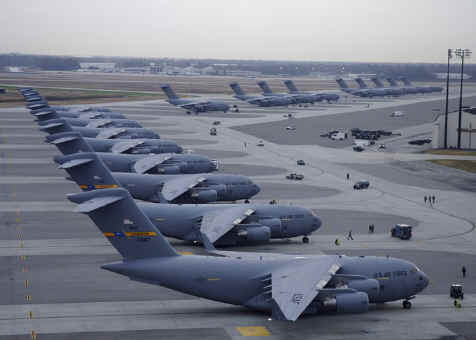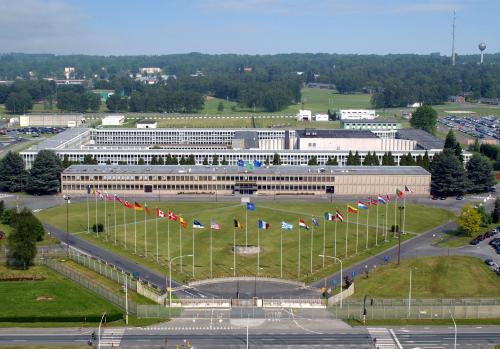The U.S. Army will finish its lengthy post-Cold war downsizing to 30,000 soldiers in Europe in 2015. It recently spun this as a sacrifice to meet current budget limitations. However, this final phase was forced upon the Army by the Bush Administration back in 2005. Former Defense Secretary Donald Rumsfeld understood military bureaucracies, which is why he was disliked by Generals. He ignored irrational objections by Generals and ordered further troop reductions in Germany after the Warsaw Pact had long disappeared, with many former members joining NATO.
 The U.S. Army wasted billions of dollars slowly implementing these
cuts by insisting new facilities were required in Europe to allow consolidation.
Army
Generals took advantage of transition confusion as the Obama administration
arrived in 2009. General John Craddock, the top Army General in Europe, began a
public campaign
to scrap the Bush-Rumsfeld plan. He announced that redeployments from Germany
would halt pending a review. Army Generals instructed their staffs to
officially squash the downsizing with recommendations in the 2010 Quadrennial
Defense Review. Congress directed the GAO to investigate and
concluded
that halting Bush's plan would require a billion dollars in new spending to
refurbish two major Army bases in Germany. The Obama administration wised up
in 2012 and ordered the Army to resume the 2005 downsizing plan.
The U.S. Army wasted billions of dollars slowly implementing these
cuts by insisting new facilities were required in Europe to allow consolidation.
Army
Generals took advantage of transition confusion as the Obama administration
arrived in 2009. General John Craddock, the top Army General in Europe, began a
public campaign
to scrap the Bush-Rumsfeld plan. He announced that redeployments from Germany
would halt pending a review. Army Generals instructed their staffs to
officially squash the downsizing with recommendations in the 2010 Quadrennial
Defense Review. Congress directed the GAO to investigate and
concluded
that halting Bush's plan would require a billion dollars in new spending to
refurbish two major Army bases in Germany. The Obama administration wised up
in 2012 and ordered the Army to resume the 2005 downsizing plan.
Since the Pentagon has been unable to restrain rising personnel costs, it must cut thousands more troops each year. Fewer troops mean fewer bases are required, which highlights the need for overdue base closings. The Obama administration recently proposed another round of domestic base closings in 2015, even after Congress has made it clear that they expect more cuts in peaceful Europe before cutting at home. While 30,000 soldiers in Europe is much smaller than our Cold War force, that is more manpower than our entire U.S. Border Patrol has to defend all American borders!
Army Generals don't care what Congress thinks. In January 2013, the Army released a detailed report on post-Iraq downsizing options, called "Army’s Programmatic Environmental Assessment for Army 2020 Force Structure Realignment." The report states: "In January, 2012, the U.S. Army announced major force reductions in Europe and other overseas locations that will occur by 2015,...Further reductions are, therefore, not being considered as a viable alternative for the realignment of Army forces as it would preclude the ability of U.S. forces to meet critical overseas mission requirements." The Army report did not mention that cuts in Europe announced in 2012 were the final phase of Cold War downsizing ordered way back in 2005.
 Generals
spin myths that U.S. troops in Europe are
closer to areas of conflict. In reality, those in Germany must move most of their
equipment by ship, which is sent to northern German ports and all the way
around Spain, so its no faster than sending units from America's east coast.
This is why the U.S. Army doesn't
have one tank left in Europe!
Generals
spin myths that U.S. troops in Europe are
closer to areas of conflict. In reality, those in Germany must move most of their
equipment by ship, which is sent to northern German ports and all the way
around Spain, so its no faster than sending units from America's east coast.
This is why the U.S. Army doesn't
have one tank left in Europe!
Units in Germany are six hours closer by air, but it takes units at least a week to prepare and assemble at an airfield to deploy, so the six flight hours saved makes little difference. Moreover, the C-17 transports needed for any major aerial deployment are not based in Europe. They must fly empty from the USA to load up units in Germany or Italy. As a result, units in USA can deploy by air just as fast as those in Europe. More importantly, any conflict in Europe would involve large, modern armies. It would be foolish to rush a few thousand lightly-armed American soldiers into combat.
NATO Commitment
Most Americans and some Congressmen argue that all our troops should be removed from Europe. American Generals prefer to engage in that discussion, knowing that political support for NATO remains strong. They say we can't cut further in Europe because we only have three combat brigades left: an airborne brigade in Italy, and a light armored brigade and an aviation brigade in Germany. However, these three brigades total less than 10,000 soldiers. What about the 20,000 non-combat soldiers in Europe? A few thousand support the bases for these combat brigades and the large hospital at Landstuhl, Germany. However, some 10,000 American soldiers in Germany serve no purpose at massive Cold War headquarter bureaucracies packed with Generals. G2mil has recommended specific closures of unneeded Army bases in Germany:
Close Baumholder, Germany - The armored brigade at this base was deactivated last year, something the Army delayed for eight years. However, the Army has no plans to close this mostly vacant base. It recently shifted a thousand unneeded headquarters and support soldiers to Baumholder to justify its continued existence.
Close Sembach, Germany - This is the Army's new base in Germany, which it deftly acquired as the U.S. Air Force closed it in 2008. It moved a few small units into its old facilities, and hopes Congress does not notice this unnecessary expansion.
Close Garmisch, Germany - This small base supports a conference center popular with Generals and Colonels for week long getaways. It would be far cheaper to close this beautiful Alpine resort and its golf course and move this center another Army base. The Army recently dropped its USAG "garrison" title and deleted it from briefing maps to better hide this facility from Congress.
 Close Stuttgart, Germany - The U.S. Army maintains two bases and
a
thousand American military personnel in Belgium for NATO's SHAPE command headquarters (pictured).
No one can justify retaining America's Cold War European
Command at Stuttgart in southern Germany, which commands the same region with the same
American commander. The United States with just three combat
brigades in Europe is not going to undertake any independent military action in
Europe outside NATO. It really can't do anything without permission
to use NATO airbases and ports. In short, the large European Command is
redundant and has no purpose! The
Army recently stopped listing Stuttgart as a U.S. Army base in Europe, classifying it
as a NATO base.
Close Stuttgart, Germany - The U.S. Army maintains two bases and
a
thousand American military personnel in Belgium for NATO's SHAPE command headquarters (pictured).
No one can justify retaining America's Cold War European
Command at Stuttgart in southern Germany, which commands the same region with the same
American commander. The United States with just three combat
brigades in Europe is not going to undertake any independent military action in
Europe outside NATO. It really can't do anything without permission
to use NATO airbases and ports. In short, the large European Command is
redundant and has no purpose! The
Army recently stopped listing Stuttgart as a U.S. Army base in Europe, classifying it
as a NATO base.
Close USAG Wiesbaden, Germany
This article offers one more base to close, U.S. Army Garrison Wiesbaden. G2mil's article about closing USAG Stuttgart diplomatically suggested consolidating the U.S. European Command into its massive U.S. Army Europe (USAREUR) "component command" at Wiesbaden, where the U.S. Army recently spent a half billion dollars for new "command" facilities. USAREUR was called 7th Army Headquarters until 2006 and commanded dozens of combat brigades during the Cold War. The Army only has three combat brigades left in Europe, which are mostly symbolic and would fight under the NATO command structure should fighting occur in Europe. As a result, USAREUR commands no combat units, just a dozen VIP aircraft at its own executive jet airfield.
USAREUR is led
by a three-star General with a huge headquarters that includes an intelligence
brigade and signal brigade designed to command a 200,000-man field army.
However, it only "commands" 30,000 soldiers, but operational command
really falls under NATO in Belgium, led by an American four-star
officer. Whatever "intelligence" mission USAREUR thinks
it performs from computer desktops at its massive new headquarters building
(pictured) can
be done from the USA. Its newly expanded base at Wiesbaden has 3400 troops, 3400
American civilian employees, 1100 German employees, and none perform any real national
security task. The Army could turn off the lights at Wiesbaden tomorrow, give
pink slips to the 1100 German employees, fly all the Americans home, and our national security would be unaffected.
Cut Army Fat in Europe
Those who want all our troops out of Europe should support this proposal. Deactivating the unneeded U.S. European Command that includes USAREUR and closing five large bases is a big step forward. Once this plan is underway, more cuts can be debated. If Congressmen found time to visit the big bases this plan leaves untouched, most would be stunned at their size and cost and demand further reductions. Nevertheless, Army Generals will express shock at this proposal to cut fat and express grave concern about its effect on national security, which they will be unable to specify.
Generals will promise to "study" options forever, and if orders are issued, delay action until Jan. 20, 2017, i.e. when the Obama administration leaves office. Keep in mind they stalled cuts ordered by the Bush administration until 2015. The Generals didn't even order the final phase of this 2005 plan until early 2013! Civilian leaders must issue specific orders to thwart delays: 1. The immediate cancellation of all PCS orders to halt the flow of military personnel to these bases. The U.S. military rotates servicemen and their families to Europe every three years, so moving personnel over three years costs nothing more. 2. An immediate civilian hiring freeze at all bases in Europe, to allow transfers from closing bases. 3. The suspension of new support contracts at bases slated for closure. 4. The closure of DoD schools at these locations within three years. 5. The closure of base commissaries and exchanges within three years.
These closings would result in a leaner U.S. Army Europe and save billions of dollars a year by allowing 10,000 soldier positions and an equal number of civilian positions to be eliminated. The U.S. Army would still have its bases in Belgium as part of the NATO command element, plus hundreds of soldiers at NATO's three regional commands. The Army would still have the same three combat brigades in Europe, its huge training complex in Bavaria, and a major hospital at Landstuhl. Overall, this plan would retain 20,000 soldiers in Europe at five large bases in Germany, two in Belgium, and two in Italy. If Army Generals balk, President Obama should threaten to bring back Donald Rumsfeld to implement this plan.
Carlton Meyer editorG2mil@Gmail.com
©2013 www.G2mil.com